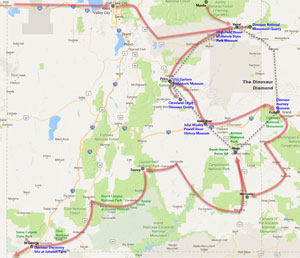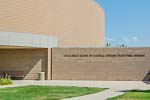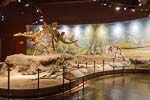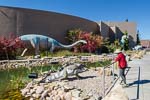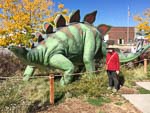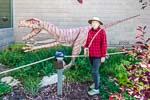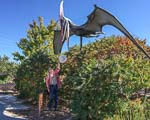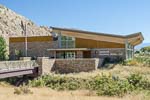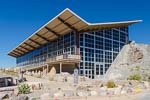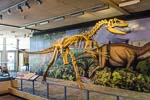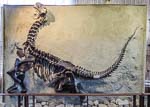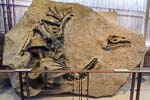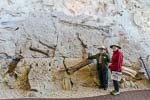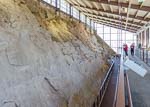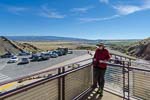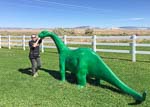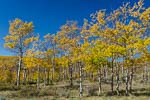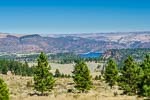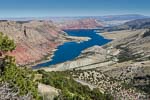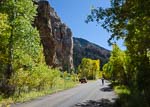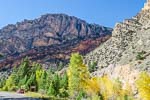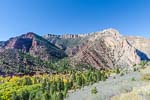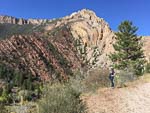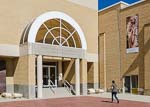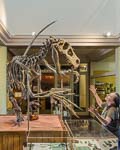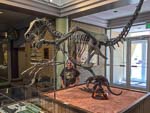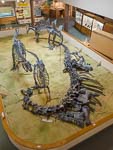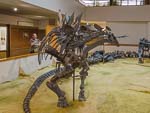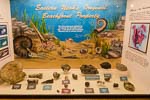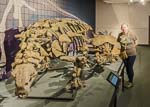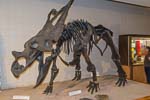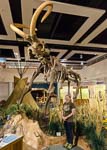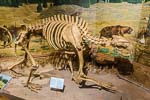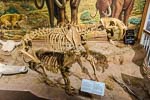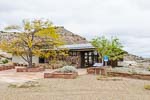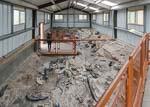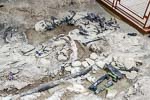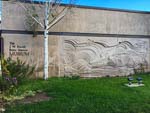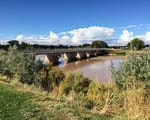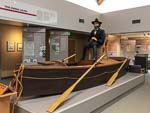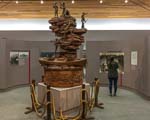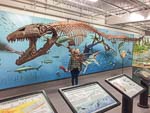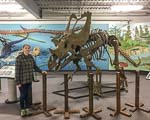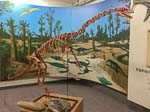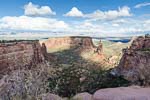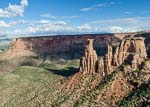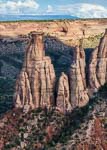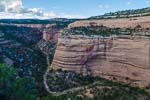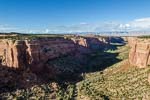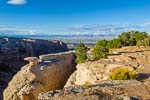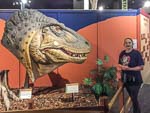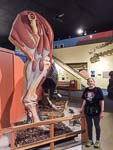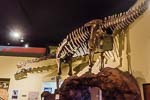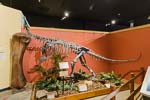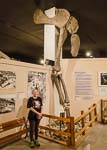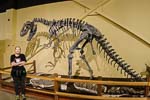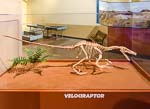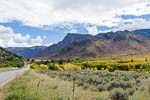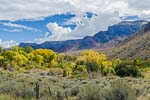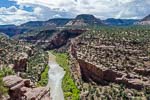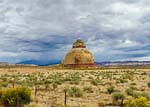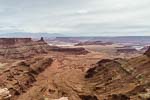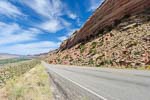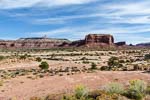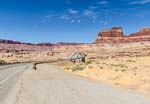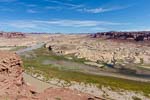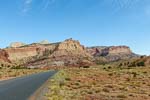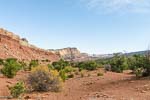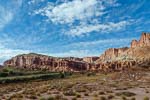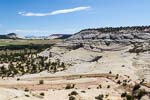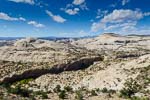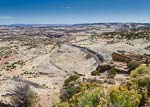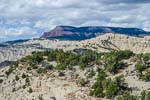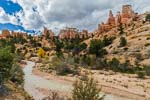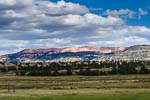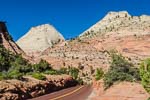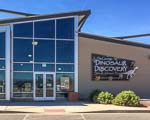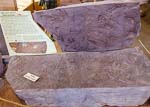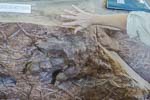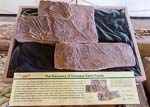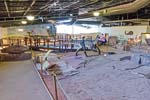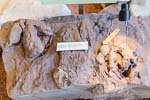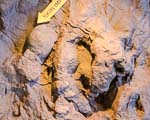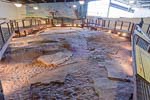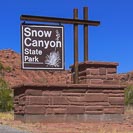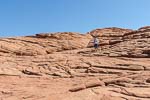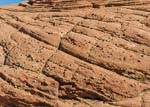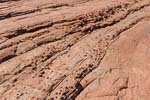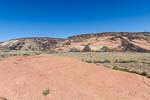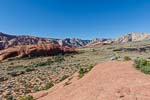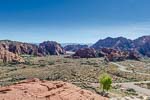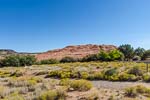The Dinosaur Diamond of East Utah and Western Colorado, September-October 2016
Denise and I visited all the dinosaur-related sites that we could find along the Dinosaur Diamond National Scenic Byway in eastern Utah and western Colorado, and while we were at it we took in some spectacular fall scenery.
3,018 miles in two weeks, exactly. Our goal was to drive the so-called "Dinosaur Diamond National Scenic Byway" and live to tell the story. I know marketing in a name when I see it, and to some extent that proved to be true, but we did the drive and visited seven museums, including one not on the Dinosaur Diamond, devoted to the paleontology of Utah and western Colorado, with a focus on dinosaurs, their fossils and other remains. The one museum outside the Dinosaur Diamond, the Dinosaur Discovery Site at Johnson Farm in St. George, was all about dinosaur tracks. Two of the sites had dinosaur fossils in situ (still in the ground): the Dinosaur National Monument Quarry and the Cleveland-Lloyd Dinosaur Quarry. (There was a third, the Hanksville-Burpee Dinosaur Quarry, located just outside Capitol Reef National Park eleven miles northwest of Hanksville, but we didn't know about it until after the trip and and it may not have been open to the public anyway.) These and the other sites displayed their fossils, or replicas when the originals were too fragile or valuable to display, and a prodigious amount of information of what is known of the dinosaurs who lived there during the Age of Dinosaurs, the so-called Mesozoic Era from approximately 245 to 65.5 million years ago (Mya). One can assume the Better Business Bureaus of the towns we visited and stayed in while on this trip were pleased by their marketing and how it brought us there.
The Dinosaur Diamond is a loop through the southwest part of the so-called Morrison Formation, late Jurassic sedimentary rock from ~156-147 Mya, that is especially rich in dinosaur fossils, outcroppings of which are found throughout the western states from southern Alberta and Saskatchewan to northern Arizona and New Mexico. The Morrison Formation has yielded the greatest number of dinosaur fossil discoveries in North America, and continues to do so. These fossils were on display in the many many museums we visited on our tour and in museums throughout the world. The Dinosaur Diamond might just as well have been extended into a Dinosaur Oval by inclusion of dinosaur sites to the north and east, but that would have been too long a drive for us. That will have to be another trip.
Please see the map above that shows the route of our adventure. The light red line is the route we traveled. I highlighted in blue the dinosaur-related sites we visited and in green the natural sites, and the Dinosaur Diamond National Scenic Byway is shown by a dashed gray line.
We began by driving to Salt Lake City and from there to Vernal UT, our first stop on the Dinosaur Diamond. From Vernal we proceeded counter-clockwise around the loop to Fruita CO. From there we drove to Moab by way of the Colorado National Monument and a beautiful scenic drive around the La Sal Mountains. Because it was still, unbeknownst to us when we made our trip plans, the height of the tourist season, we had to spend a night in Monticello UT before our reservations in Moab were available. The insane crowds at Arches and Canyonlands National Parks caused us to cut our stay short, so we began our drive homeward. We headed home via Torrey, the beautiful Highway 12 drive over Boulder Pass and the slick rock badlands near Escalante, and St. George where the last of the paleontology museums was located. From St. George it was a 14 hour drive home.
Utah Field House of Natural History Museum, Vernal UT: This museum was our first stop in the Dinosaur Diamond. It was a modest museum with a modest display of dinosaur skeletons on display, but it looked like great fun for children with its Dinosaur Garden that contained many full-size reconstructions of dinosaurs discovered locally. Many of the reconstructions were done in the 1970s prior to the modern understanding of how dinosaurs stood and moved, but the reconstructions nonetheless gave one a good feeling for the size of these animals. In the rotunda of the museum was a magnificent Diplodocus, and in the Jurassic Gallery were several other dinosaur skeletons, including a Stegosaurus and an Allosaurus.
Dinosaur National Monument, Vernal UT was created in 1915 and has over 800 paleontological sites within its borders. The monument also encompasses some magnificent scenery around the confluence of the Green and Yampa Rivers and spans the border of Utah and Colorado. It is perhaps best known for the Carnegie Dinosaur Quarry and its "Wall of Bones" where dinosaur fossils were purposefully left in place in 1924 after 15 years of excavations for the future education of visitors. The dinosaur quarry is located just a few miles north of Vernal. This was our second stop on the Dinosaur Diamond.
Flaming Gorge NRA: We took a day drive north from Vernal through the Flaming Gorge NRA to the little town of Manila just south of the Wyoming border where we had lunch. On our way back we took a scenic loop road through the Sheep Creek Canyon Geological Area in the Uinta Mountains to the west of Flaming Gorge. The day was gorgeous, the trees were in their fall colors, and the geology was magnificent like everywhere in Utah.
Prehistoric Museum, College of Eastern Utah, Price UT is a very nice little museum devoted to prehistory, as its name suggests, including dinosaurs and the megafauna of the Pleistocene and early humans. There are many very nice fossil skeletons on display here including a splendid, and frankly scary, Utahraptor posed as if in the act of disemboweling a prey.
Cleveland-Lloyd Dinosaur Quarry, 32 miles south of Price UT: This quarry contains the largest concentration of Jurassic Age bones ever discovered. Over 12,000 bones belonging to an estimated 74 individuals were recovered. It is also an enigma in that the great majority of the bones belonged to carnivores who made up only ~10% of the dinosaur population. The quarry is located about 32 miles south of Price over generally good dirt roads, though the directions weren't always well marked at intersections.
John Wesley Powell River History Museum, Green River UT: This museum is on the banks of the Green River on Interstate 70 and is largely devoted to John Wesley Powell's explorations of the Green and Colorado Rivers in 1869 and 1871-2. Powell was the first to scientifically explore the Grand Canyon and mapped the last unmapped sections of the United States. Why it is located here and not in Green River, Wyoming where the 1869 exploration began underneath the then newly completed intercontinental railroad bridge across the Green River, I don't know. The main floor exhibits are devoted to John Wesley Powell, but to our surprise there are some very interesting paleontological exhibits in the basement.
Colorado National Monument is a beautiful but modest-sized park. We arrived about 4:00pm at the visitor center inside the north entrance perhaps 5 miles outside of Fruita, Colorado. The idea was to get the materials we needed on the park so we could plan a visit for the next morning. Instead we were told there would be over 2,000 bicyclists riding through the next morning in some kind of event, so we decided to do the drive right away, and we were glad we did. It took us perhaps an hour to complete the drive to the south entrance and Grand Junction. The park has nice geology and some great views over the Colorado River Valley and the towns of Fruita and Grand Junction, but in our opinion it is nothing special and offers nothing you can't see in the great number of other parks on the Colorado Plateau.
Dinosaur Journey Museum, Fruita CO: We thought this was going to be a kiddy museum from the pictures of the dinosaur reconstructions on its website, but we were wrong. There are certainly reconstructions, but they're very well done and they complement the many fossil skeletons on display. In all, this is a nice little museum.
From Fruita to Moab: Unaweep Valley and Dolores River Canyon. We decided to take a scenic route to Moab from Fruita: south on highway 141, west on 90 and 46, and north on 191. Unaweep Canyon proved to be a surprise in its almost pastoral beauty with fall colors and its unique geology, and the Dolores River Canyon was ruggedly beautiful red-rock country with some interesting history.
From Moab to Saint George UT: Capitol Reef, State Scenic Byway 12, Bryce and Zion National Parks. We did this drive in two steps. First we drove to Torrey via the scenic highways 95 and 24 that took us over the Colorado River at the upstream end of Lake Powell and through Capital Reef National Park. The next morning we drove one of the most scenic highways, in our opinion, in Utah, National Scenic Highway 12 over Boulder Pass and through the amazing Navajo Sandstone badlands between the pass and Escalante. After lunch in Escalante we finished the day's drive to Saint George by driving through the eastern edge of Bryce Canyon National Park on highway 12, and then through Zion National Park on highway 9.
The Dinosaur Discovery Site at Johnson Farm, St. George UT: This museum is unique on this trip in that its focus is on dinosaur trackways rather than dinosaur fossils, specifically the dinosaur tracks found at the Johnson Farm in 2000. The tracks date to the Early Jurassic, approximately 200 Mya, and are found in sandstone and mudstone that was once a lakeside environment, which facilitated the preservation of footprints of many species of dinosaurs, swimming claw marks, and even a very rare butt print of a sitting dinosaur. The museum building preserves a large portion of the tracks for display and study.
Snow Canyon State Park is a lovely small park at the northern end of Saint George. It is famous for its creamy white to red colored cross-bedded sandstone hills and cliffs. It is also famous for an execrable John Wayne movie made there in 1954, the Conqueror.

